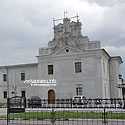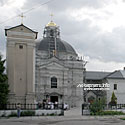Ukraine
Lviv region
Chervonohrad district
Chervonohrad
Worth seeing
Worth seeing in Chervonohrad
-
Basilian Monastery Complex
The Basilian monks arrived at the town on the invitation of Francisk Pototsky in 1764.
The church of St. Yuriy and the monastery building were constructed in 1776. The author of the project was Ivan Zelner who combined features of two styles — baroque style and classicism. The monastery had a large library, the future Metropolitan Andrey Sheptytsky made vows here.
The monastery also was famous for its miracle-making icon, that had been returned to the church in 1994.
Now it is a Greek-Catholic church.Address: Chervonohrad, B. Khmelnytsky St. 21 -
Church of the Descent of the Holy Spirit
The church of the Descent of the Holy Spirit was built during 1692-1704. Józef-Felitsian Potocki gave money for the construction of the church in baroque style. The interiors were painted by Stanislaw Stroyinski, the famous artist. The Bernardine monastery was founded here.
The Roman-Catholic parish existed till 1951, when the town was included to USSR and got the name Chervonohrad.
The church was restored in 1927. But years passed, and with time it was coming to ruin.
In 1988 the church was given to the local Orthodox community. Now it is the Orthodox church of St. Volodymyr.Address: Chrvonohrad, B. Khmelnytsky St. 22 -
Pototski Palace
The Pototski Palace was built in 1756-1760 by Francisk-Sileziy Pototsky, the town owner of the time.
The town was called Khrystynopil at that period, and the Palace became the local residence of Francisk Pototsky.
The author of the project was Pierre Rico de Tirredzhelli, a French architect who later became the personal architect of Fridrich the Great, the Prussian King.
The Royal Palace in Wilanow near Warsaw served as an example.
In times of Francisk the Palace was considered to be an architectural perl that combined two styles — baroque and classicism.
The park in French-Italian style was the great 'saloon' and the Palace decoration. It followed the parks in Versal and included water attractions — canals, pools, fountains; beautiful flowers and antique sculpture.
Unfortunately, a liitle part of the former magnificentn complex had been preserved. Now the museum is situated here.
Its restoration is now one of the most important tasks because the Palace is a unique monument of the palace architecture of the middle XVIII c. in the northern part of Lviv region.Address: Chervonohrad town

 Ukraine
Ukraine Poland
Poland Slovakia
Slovakia
 Українською
Українською



